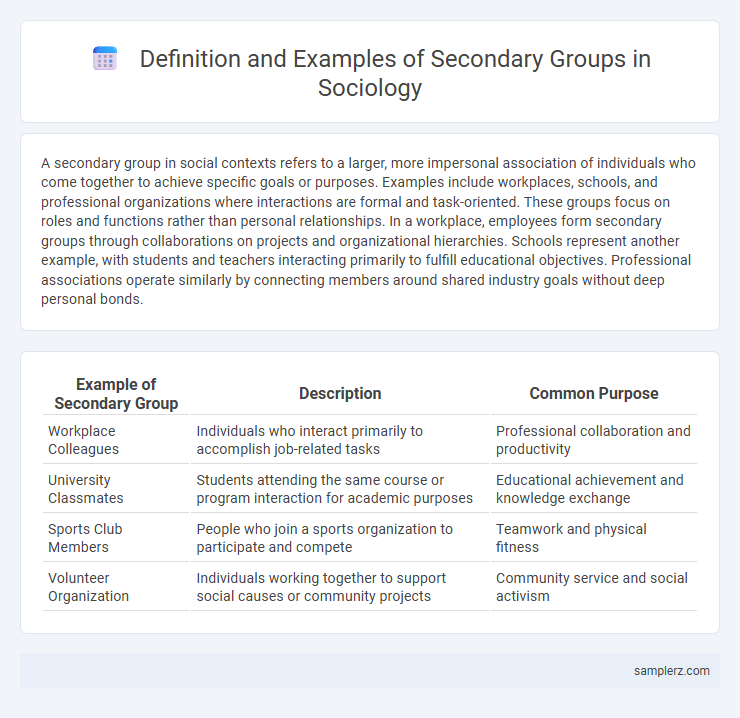A secondary group in social contexts refers to a larger, more impersonal association of individuals who come together to achieve specific goals or purposes. Examples include workplaces, schools, and professional organizations where interactions are formal and task-oriented. These groups focus on roles and functions rather than personal relationships. In a workplace, employees form secondary groups through collaborations on projects and organizational hierarchies. Schools represent another example, with students and teachers interacting primarily to fulfill educational objectives. Professional associations operate similarly by connecting members around shared industry goals without deep personal bonds.
Table of Comparison
| Example of Secondary Group | Description | Common Purpose |
|---|---|---|
| Workplace Colleagues | Individuals who interact primarily to accomplish job-related tasks | Professional collaboration and productivity |
| University Classmates | Students attending the same course or program interaction for academic purposes | Educational achievement and knowledge exchange |
| Sports Club Members | People who join a sports organization to participate and compete | Teamwork and physical fitness |
| Volunteer Organization | Individuals working together to support social causes or community projects | Community service and social activism |
Understanding Secondary Groups in Social Contexts
Secondary groups in social contexts exemplify large, impersonal, and goal-oriented associations such as workplaces, universities, or professional organizations. These groups differ from primary groups by emphasizing formal relationships and structured interactions rather than emotional bonds. Understanding secondary groups sheds light on how individuals collaborate, establish social roles, and achieve shared objectives within complex societal frameworks.
Key Characteristics of Secondary Groups
Secondary groups are large, impersonal social groups organized around specific goals or activities, such as coworkers in a company or members of a professional association. They are characterized by formal roles, weak emotional ties, and limited personal interaction compared to primary groups. These groups emphasize task-oriented relationships and often operate within structured settings to achieve common objectives.
Workplace Teams as Secondary Groups
Workplace teams serve as prime examples of secondary groups, characterized by formal, goal-oriented relationships where members collaborate to achieve specific professional objectives. Unlike primary groups, workplace teams emphasize structured roles, task-focused interactions, and limited emotional connections, fostering efficiency and productivity. This dynamic supports organizational success by leveraging diverse skills and shared responsibilities within a defined professional environment.
Educational Institutions: Classrooms and Clubs
Secondary groups in social contexts often include educational institutions such as classrooms and clubs, where interactions are goal-oriented and structured around shared activities or learning objectives. Classrooms foster formal relationships centered on knowledge acquisition and academic performance, while clubs provide a platform for socializing and skill development among members with common interests. These groups exhibit limited emotional intimacy but play a crucial role in shaping social skills and networks outside the family or primary group settings.
Religious Organizations and Their Social Functions
Religious organizations serve as secondary groups by providing structured environments where individuals engage in shared beliefs and rituals, fostering social cohesion beyond primary family ties. These groups facilitate social functions such as community support, moral guidance, and social networking, influencing members' values and behaviors. Through organized activities and charitable efforts, religious organizations contribute significantly to social integration and collective identity formation.
Volunteer Associations and Community Service Groups
Volunteer associations and community service groups exemplify secondary groups characterized by formal, goal-oriented relationships rather than emotional bonds. Members collaborate on shared objectives such as organizing events, fundraising, or providing aid, emphasizing task completion over personal connections. These groups foster social cohesion and civic engagement within communities by uniting individuals with common interests in secondary, structured interactions.
Professional Societies and Unions
Professional societies and unions are prime examples of secondary groups characterized by formal, goal-oriented relationships among members. These organizations facilitate networking, professional development, and collective bargaining, often representing workers' interests in various industries. Their structured environments foster collaboration without the intimacy typical of primary groups, emphasizing shared objectives over personal bonds.
Online Communities and Social Networks
Online communities and social networks exemplify secondary groups by connecting individuals based on shared interests rather than personal relationships. Platforms like Facebook, Reddit, and LinkedIn facilitate interactions among diverse members who collaborate, share information, and support collective goals. These virtual spaces foster social cohesion and enable networking beyond geographical boundaries.
Government and Civic Committees
Secondary groups in social contexts often include government agencies and civic committees, where individuals collaborate based on formal roles and shared objectives rather than personal relationships. These groups emphasize structured interactions, such as policy-making, community planning, or public service initiatives, reflecting a goal-oriented dynamic. Membership in such groups is typically defined by official positions and responsibilities, facilitating organized efforts within larger societal frameworks.
Sports Teams and Extracurricular Groups
Secondary groups in social contexts often include sports teams and extracurricular groups, which bring together individuals for specific activities rather than personal relationships. These groups emphasize goal-oriented interactions, structured roles, and shared interests such as athletic competition or club involvement. Participation in sports teams and extracurricular activities fosters collaboration, skill development, and social networking within larger community settings.

example of secondary group in social Infographic
 samplerz.com
samplerz.com